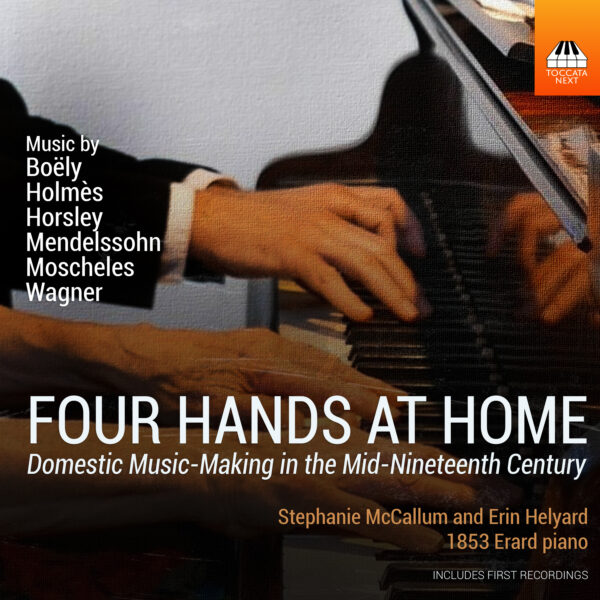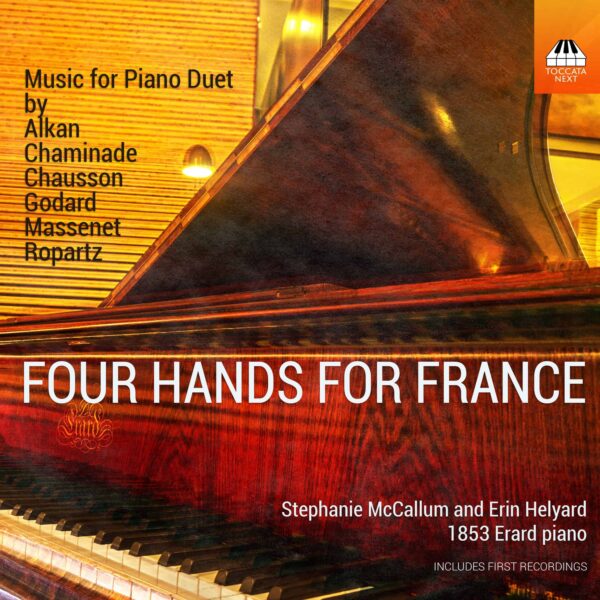Four Hands at Home: Domestic Music-Making in the Mid-Nineteenth Century
Playing piano four-hands was both vital in the dissemination of music in the nineteenth century and also a popular domestic activity. The original 1853 Parisian Erard piano on which this recording was made demonstrates the clarity, warmth and differentiated timbres characteristic of the ‘straight stringing’ that was later replaced by the ‘cross-stringing’ of the modern concert grand. The repertoire from the period covers the many genres of four-hand piano works in their varied roles as domestic ‘info-entertainment’: orchestral works large and small, serious sonatas and variations, showpieces for emerging virtuosi and even a string quartet are all equally engaging in this once-familiar medium.
Stephanie McCallum (primo) and Erin Helyard (secondo), 1853 Érard Piano
Ignaz Moscheles
- La belle union: Rondeau brillant précédé d’un Introduction, Op. 76 (c. 1828)* (13:20)
Richard Wagner
Lohengrin (trans. anon)
- Vorspiel* (7:47)
Felix Mendelssohn
Andante and Variations, Op. 83a (1841, rev 1844) (13:31)
- Andante tranquillo (1:07)
- Var. 1: Cantabile (1:02)
- Var. 2: Animato (1:06)
- Var. 3 (0:59)
- Var. 4 (0:49)
- Var. 5 (0:47)
- Var. 6 (1:06)
- Var. 7 (0:55)
- Var. 8: Allegro molto agitato (5:40)
Charles Edward Horsley
Three Chamber Duets, Op. 46 (1857)* (11:11)
- No. 1, Andante maestoso (3:47)
- No. 2, Allegretto scherzando (2:41)
- No. 3, Adagio. Allegro agitato (4:43)
Alexandre-Pierre-François Boëly
String Quartet No. 3 in G Major, Op. 31 (c. 1824-27) (23:57)
- I. Allegro ma non troppo (9:36)
- II. Adagio (6:05)
- III. Scherzo. Allegro (2:39)
- IV. Rondo. Allegro (5:37)
Augusta Holmès
- Pologne: Poème symphonique (1883)* (12:03)
*First Recordings


Stretto :
‘De originele, Parijse Erard-piano uit 1853, waarop deze opname is gemaakt, combineert vanwege de rechte snaren, warmte met een bel-achtige helderheid, waardoor een verrassende verscheidenheid aan aantrekkelijke, expressieve texturen wordt geproduceerd.’
—Michel Dutrieue, Stretto
Diapason :
‘Ce « rondeau brillant », certes un peu bavard et recourant fréquemment à des gammes ascendantes, permet d’apprécier la sonorité délicate et la transparence d’un piano Erard de 1853. Ces qualités sëduisent encore davantage dans la transcription du Prélude de Lohengrin, le timbre de l’instrument convenant parfaitement aux ambiances diaphanes, célestes, de j’oeuvre.
Les Variations op. 83a de Mendelssohn, par leur inventivité rythmique, harmonique et mélodique, illustrent l’expressivité des interprètes. […] Celle de Pologne d’Augusta Holmès, prus réussie et parcourue de réminiscences wagnériennes, clôt superbement cette « séance » intimiste.’
—Jérôme Bastianelli, Diapason, January 2025
WTJU :
‘Stephanie McCallum and Erin Helyard make a great team. They play with one accord, and the music benefits. There were times when I couldn’t tell if one or two people were playing. The pair bring out the Romantic expression in these works, without over-doing it.
An interesting audio recreation of a time gone by. And a revival of some sadly-neglected repertoire.’
—Ralph Graves, WTJU